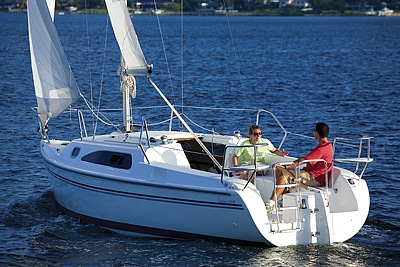
If two boats are overly alike and your aim is to compare and contrast them, you’ll find yourself splitting hairs in a frustrating attempt to distinguish one from the other. If the same two boats are mournfully distant, you’re relegated to the age-old conundrum of addressing apples and oranges. Happily, none of this pops up in a discussion of the Catalina 250 Keel and the Bremer 25. Indeed, here are two new 25 footers with as many similarities as idiosyncrasies, two little boats with a common interest, namely to provide a lot of versatility and fun in 25 feet, and divergent means to that end. In one case you’ve got a cruiser with amenity, in the other a performance platform with more basic accommodations.
Typically, the design team at Catalina has brought to bear in their newest pocket cruiser abundant experience building capable boats for conventional sailors. The fixed-keel version of the Catalina 250 solves the stability problem that tainted its water-ballasted centerboard-equipped predecessor, and does so with a glorified interior that features some refined finish work and a lot of cushioned, comfort-oriented volume. On the other hand, Mark Bremer’s plumb-stem racing cruiser with its bulb-equipped daggerboard sacrifices a bit of cockpit space, deck expanse and interior appointment for quickness, agility and a more ambitious sailplan.
The Catalina is constructed of solid glass hand laid using polyester and vinylester resins. The deck is balsa cored for stiffness and reduced weight. Hull rigidity is promoted by means of longitudinal and athwartship stiffeners tied into elements of the interior furniture, an established Catalina building strategy that has proven successful in various other models. The hull-deck joint involves an out-turned flange sealed and mechanically fastened, then finished on the outside with a vinyl rubrail. Two keels are available – a 4’7″ fin and a 3’5″ wing – both of which are rendered in cast lead and bolted externally. The rudder is a deep, high-aspect, transom-hung foil built of fiberglass and foam, tiller steered (wheel steering optional).
Mark Bremer has taken the other approach. The Bremer 25 hull and deck are vacuum bagged using biaxial FRP, epoxy and Core-Cell foam core. The hull-deck joint features an in-turned flange sealed and mechanically fastened, then trimmed off with a conventional aluminum on-deck toe rail. Ballast is by way of a lead bulb affixed to the bottom of a 6’2″ retractable high-aspect fiberglass fin; the foil incorporates positive locking both in the down position when deployed and in the up position when shipped for trailering.
Catalina 250 Fixed Keel Specifications:
* LOA: 25’0″ (7.62 m.)
* LWL: 21’3″ (6.48 m.)
* Beam: 8’6″ (2.59 m.)
* Draft (fin): 4’7″ (1.4 m.)
* Draft (wing): 3’5″ (1.04 m.)
* Ballast (fin): 895 lbs. (406 kgs.)
* Ballast (wing): 1,050 lbs. (477 kgs.)
* Disp (fin): 3,300 lbs. (1,498 kgs.)
* Disp (wing): 3,455 lbs. (1,569 kgs.)
* Sail area (100%): 295 sq.ft. (27.4 sq.m.)
* Mast above water: 36’3″ (11.1 m.)
* Ballast/Disp: .27 (fin); .30 (wing)
* Disp/Length: 154 (fin); 161 (wing)
* SA/Disp: 21.3 (fin); 20.7 (wing)
* Fuel: 6 gal. (22.7 ltr.) portable
* Water: 12 gal. (45 ltr.)
* Holding: N/A (Porta Potti)
* Auxiliary: Outboard opt.
* Headroom: 5’5″ (1.7m.); w/poptop 7’1″ (2.2m.)
* Designer: Catalina Design Team
* Base price: $18,399 FOB CA
Catalina Yachts
21200 Victory Boulevard
Woodland Hills, CA 91367
Phone: (818) 884-7700
Fax: (818) 884-3810

The numbers tell a lot about how and where the two boats diverge. The Catalina 250 tips in at between 3,300 and 3,500 pounds displacement, actually lighter than the Bremer 25 which is closer to 3,800 pounds. The discrepancy is evident in the ballast figures – for the Catalina, between 895 and 1,050 pounds, for the Bremer, fully 1,600. The Catalina 250 carries a Ballast/Disp ratio of 27 to 30 percent, depending on the keel you select, while the Bremer’s Ballast/Disp ratio is way up around 42. Additionally, the Bremer carries its ballast two feet deeper. This means that the Bremer is stiffer, more powerful and more capable of flying the added asymmetrical reaching canvas for which she is designed.
Although sail area with 100 percent foretriangle is comparable, the Catalina sports a masthead rig with a fairly benign working jib, while the Bremer is fractionally rigged with a lapping genoa. Also, with more waterline length (22’6″ vs. 21’3″), the Bremer actually enjoys a lower Disp/Length number, which means greater speed and acceleration potential.
In short, then, the Bremer favors the performance end of the pocket cruiser spectrum while the Catalina falls into a more conservative slot. What the 250 gains in lieu of breakneck racing appeal is more space in the cockpit, more volume below, and decks that are easier to run around on to be sure, a more livable package overall.
Below, the Catalina gives you a wide-open interior with a large athwartship double berth beneath the cockpit, an enclosed head to port, working galley to starboard, open U-shaped saloon in the middle of the boat and a small but cozy V-berth all the way forward. The head includes a portable marine toilet, a vanity with a manual-pump sink, and even a sizable wet locker aft to solve the problem below of gear adrift. The galley provides a built-in butane stovetop, a sink with a pump, drawer space, a large cooler niche and a 12-gallon freshwater cache. And the kicker? When the sails are down at the end of the day and you’re enjoying a quiet spot at the end of an anchor rode, open the companionway and rig the canvas pop-top, which brings you standing headroom at the galley end of the saloon and extends the living space out into the cockpit.
The Bremer is six inches narrower overall, the cabin structure narrower still, and the forward sections extremely fine, all of which lead to different solutions below. The largest single element is a huge seven-by-seven-foot aft berth beneath the cockpit. Forward is a smallish saloon with seats and lockers outboard, a galley area beyond that to port and an enclosed head on the starboard side behind the trunk for the retractable keel. Another berth occupies the forepeak. The galley includes a sink and food locker but longs for a built-in stove. Indeed, the interior comprises everything you need for basic camping out, but it lacks the openness, volume and amenity you’d prefer for spreading yourself out, cooking up a storm and sticking your feet up at the end of the day.
We sailed both these boats in similar light-to-medium conditions on Chesapeake Bay last fall. True to form, the Bremer accelerated well, tracked like a monorail and stood up to any puffs. Response at the helm was instant and refined; reaction to subtle trim, noticeable and attentive. The jib on this boat features roller furling with the unit recessed into the bow, and this keeps the airflow attached down low on what is truly a deck-sweeper of a headsail. A deck-fitted sprit can be deployed from the cockpit by yanking on a clever tackle arrangement; off the breeze we launched an asymmetrical kite from the end of this and charged along in good control.
The Catalina is less tricked out under sail but she is light enough, powered-up enough and sensitive enough to remain satisfying at the helm just the same. The jib sheets inboard of the shrouds for weather work, and the rig is located fairly far forward to keep the center of effort from moving aft and taking over the helm in breezy conditions. We had no trouble making the boat go, and in terms of the simplicity of her sailplan and trimming scenario, she probably makes more sense for cruising families and less advanced sailors. She is a congenial vessel with a lot to offer in 25 feet.
Both boats come with 12-volt systems for nav lights outside, house lights inside and other applications such as communications. Auxiliary power is provided in the form of outboards on stern brackets; fuel storage is addressed in vented cockpit lockers designed to hold portable tanks. One particularly fetching feature aboard the Catalina is its open transom and folding stern ladder, certainly a worthwhile perk when you consider how aquatic your activities are apt to be while cruising on a vessel this size.
In a word, the Bremer 25 and the Catalina 250 offer two very viable ways to have FUN in 25 feet. Each is loyal to its design purpose, each tackles the theme with sophisticated attention to detail.
Bremer 25 Specifications:
* LOA: 25’0″ (7.62 m.)
* LWL: 22’6″ (6.86 m.)
* Beam: 8’0″ (2.44 m.)
* Draft (keel deployed): 6’3″ (1.9 m.)
* Draft (keel retracted): 2’6″ (0.8 m.)
* Ballast: 1,600 lbs. (726 kgs.)
* Disp: 3,800 lbs. (1,724 kgs.)
* Sail area: 308 sq.ft. (28.6 sq.m.)
* Mast above water: 40’3″ (12.3 m.)
* Ballast/Disp: .42
* Disp/Length: 149
* SA/Disp: 20.2
* Fuel: Portable tank
* Water: 3 gal. (11.4 ltr.)
* Holding: N/A (Porta Potti)
* Auxiliary: Outboard
* Cabin headroom: 6’0″ (1.83 m.)
* Designer: Mark Bremer
* Base price: $32,500
Bremer Marine Inc.
4 Longfellow Place, Suite 2509
Boston, MA 02114
Phone: (617) 742-4915
Fax:(617) 720-5892








